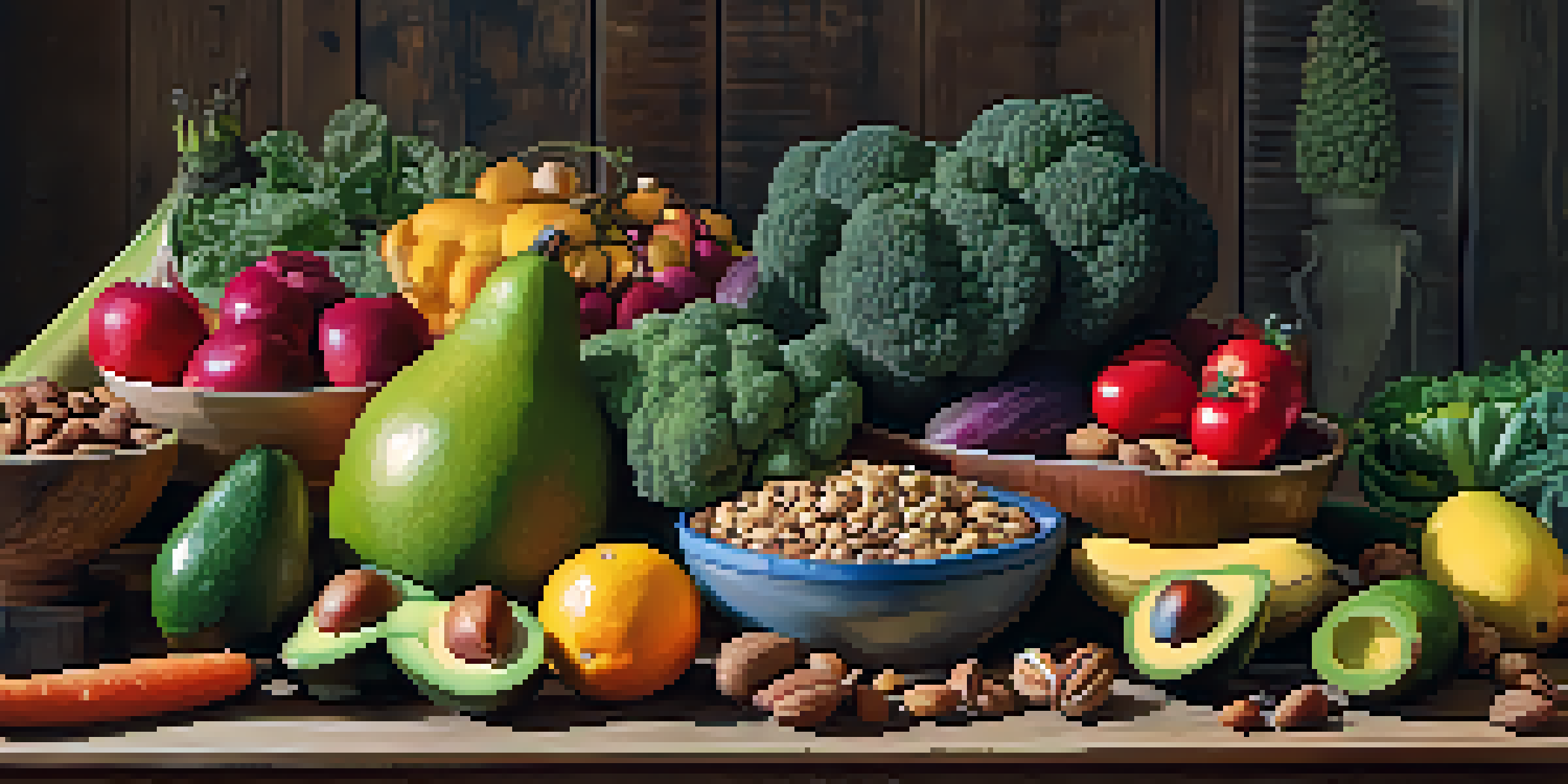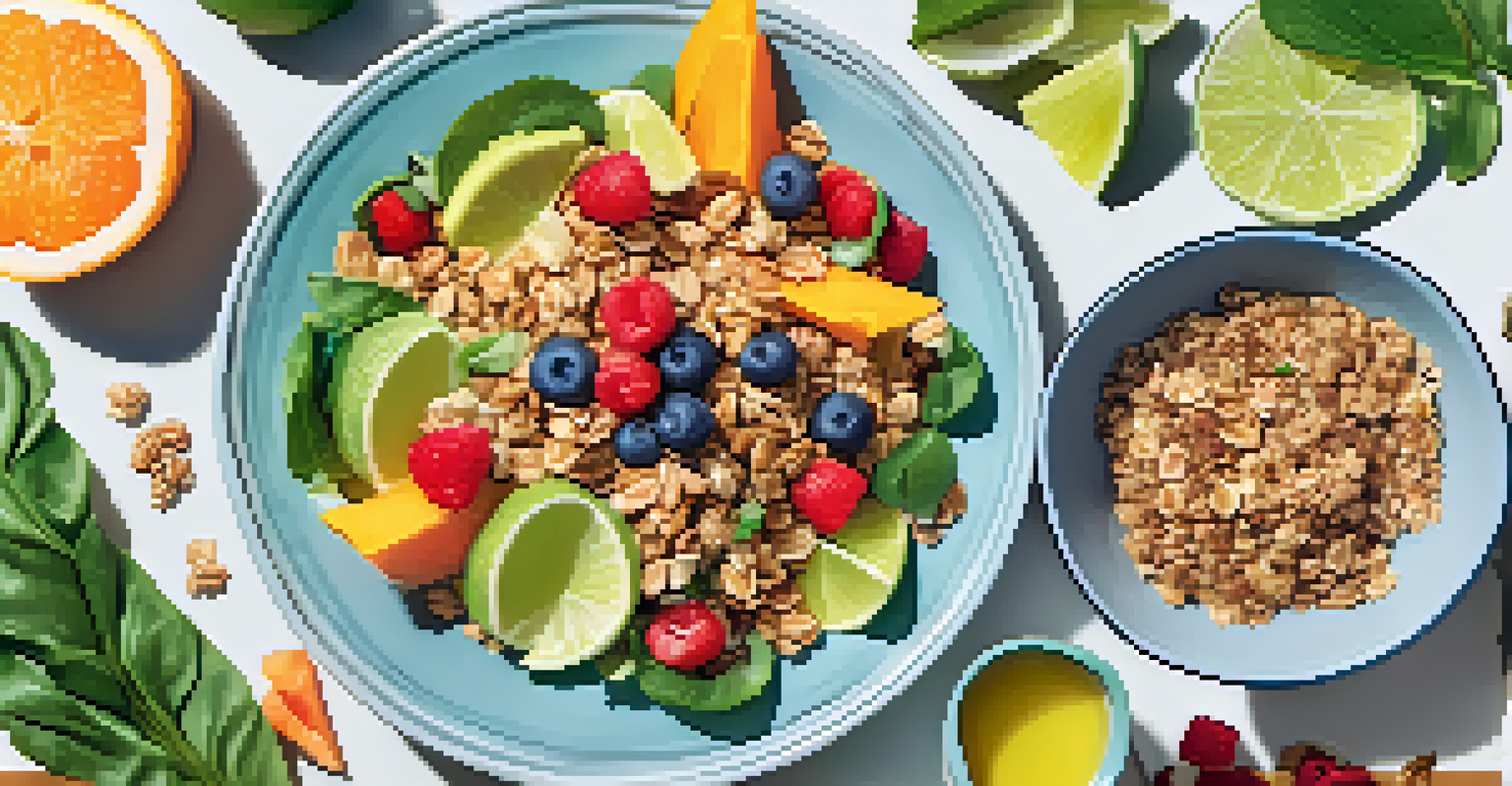Creating Raw Food Meal Plans for Beginners: A Complete Guide

Understanding the Raw Food Diet: What You Need to Know
The raw food diet revolves around consuming unprocessed and uncooked foods, primarily fruits, vegetables, nuts, and seeds. This approach is believed to maximize the nutritional content of the food, as cooking can destroy many vitamins and enzymes. For beginners, understanding the basics of this diet is essential to making informed choices.
Let food be thy medicine and medicine be thy food.
Many raw food enthusiasts argue that this diet can lead to better digestion and energy levels, among other health benefits. However, it’s important to note that not all raw foods are created equal; some may require specific preparation methods to enhance their digestibility and nutrient absorption. As you embark on this journey, keeping an open mind and a willingness to experiment can be beneficial.
Starting a raw food diet may seem daunting, but with the right mindset and meal planning, it can be an enjoyable and rewarding experience. This guide will help you navigate through your first steps, from understanding the diet to creating delicious meal plans tailored to your needs.
Essential Ingredients for Your Raw Food Pantry
Building a raw food pantry means stocking up on fresh produce, nuts, seeds, and other whole foods. Fruits and vegetables like avocados, kale, and bananas should be staples in your kitchen because they are versatile and packed with nutrients. Additionally, having a variety of nuts and seeds can provide healthy fats and protein to your meals.

Consider adding items like coconut oil, nutritional yeast, and chia seeds to your pantry. These ingredients not only boost flavor but also enhance the nutritional profile of your dishes. By keeping your pantry well-stocked, you’ll always have the essentials on hand to whip up delicious raw meals.
Raw Food Diet Basics Explained
Understanding the raw food diet involves consuming unprocessed foods to maximize nutritional content and enhance health.
Don’t forget about herbs and spices! They can elevate the taste of your raw dishes and keep your meal plan exciting. Experimenting with different flavors can help you discover new favorites and make meal prep a delight rather than a chore.
Creating a Balanced Raw Food Meal Plan
A balanced meal plan is key to ensuring you’re getting all the nutrients your body needs. Aim to incorporate a variety of colors and textures in your meals, as this not only makes your plate visually appealing but also maximizes nutrient diversity. Think of your meal plan as a rainbow; the more colors, the better!
You are what you eat, so don't be fast, cheap, easy, or fake.
When planning your meals, consider including a mix of fruits, leafy greens, nuts, and healthy fats. For example, a typical day might include a green smoothie for breakfast, a hearty salad for lunch, and a raw pasta dish made from zucchini noodles for dinner. This variety keeps your meals interesting and satisfying.
Remember to listen to your body and adjust your meal plan as needed. If you find certain foods make you feel sluggish or unwell, don’t hesitate to swap them out for alternatives. Meal planning is a flexible process, and finding what works for you is part of the journey.
Simple Raw Food Recipes for Beginners
Starting with simple recipes can help ease you into the raw food lifestyle. Think of easy dishes like raw granola made from oats, nuts, and dried fruits, or a refreshing fruit salad drizzled with lime juice. These recipes require minimal preparation and highlight the natural flavors of raw ingredients.
Another beginner-friendly option is a raw vegetable wrap, using large leafy greens to hold your favorite fillings like hummus, shredded carrots, and sliced bell peppers. These wraps are not only delicious but also portable, making them perfect for lunch on the go. You’ll quickly discover that raw food doesn’t have to be complicated!
Essential Ingredients for Success
Stocking your pantry with fresh produce, nuts, seeds, and flavorful herbs is crucial for creating balanced raw meals.
Don’t shy away from trying out raw desserts too. A simple recipe for raw chocolate brownies made from dates, nuts, and cocoa powder can satisfy your sweet tooth without any guilt. As you grow more comfortable, you can experiment with more complex recipes and techniques to expand your culinary repertoire.
Tips for Staying Motivated on a Raw Food Journey
Staying motivated on a raw food diet can be challenging, especially in the beginning. One effective way to maintain your enthusiasm is to set achievable goals, such as trying one new recipe each week or incorporating more raw meals into your daily routine. Celebrating small milestones can boost your confidence and keep you engaged.
Joining a community of like-minded individuals can also make a significant difference. Whether online or in-person, sharing experiences, recipes, and challenges with others can provide support and encouragement. You might find inspiration in others' journeys, which can help you stay committed to your own.
Lastly, allow yourself some flexibility. If you find yourself craving cooked foods, it’s okay to indulge occasionally. The key is to find a balance that works for you, ensuring that your raw food journey remains enjoyable rather than restrictive.
Overcoming Common Challenges in Raw Food Meal Planning
Like any lifestyle change, transitioning to a raw food diet can come with its own set of challenges. One common hurdle is the time commitment required for meal prep. However, with some planning, you can streamline the process by preparing larger batches of staples or pre-packaged snacks to save time during the week.
Another challenge can be social situations where raw food options might be limited. In these cases, consider bringing your own dish to share or suggesting restaurants with raw food options. By preparing ahead and communicating your dietary preferences, you can enjoy social gatherings without feeling left out.
Overcoming Raw Diet Challenges
Navigating challenges in a raw food diet requires planning, flexibility, and support from like-minded communities.
Lastly, be patient with yourself. It’s normal to feel overwhelmed at times, so remember that it’s a journey rather than a race. Embrace the learning curve, and soon enough, you’ll find your rhythm and feel more confident in your raw food meal planning.
Maintaining a Healthy Raw Food Lifestyle Long-Term
Transitioning to a raw food lifestyle is not just about the food; it’s about creating sustainable habits that support your well-being. Regularly revisiting your meal plans and adjusting them based on seasonal produce can keep your diet fresh and exciting. Being mindful of the foods you enjoy will help you maintain a long-term commitment.
Incorporating variety is essential for preventing boredom and ensuring you receive a broad spectrum of nutrients. Explore local farmers' markets or join a community-supported agriculture (CSA) program to discover new ingredients and recipes. The more you experiment, the more you'll discover the endless possibilities within raw food.

Lastly, always keep your health goals in mind. If you find that certain raw foods aren’t serving you well, don’t hesitate to make swaps or adjustments. A healthy lifestyle is about balance and listening to your body, so take the time to reflect and adapt as needed.